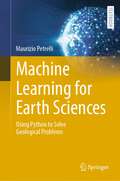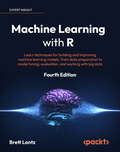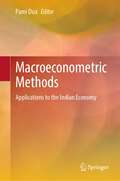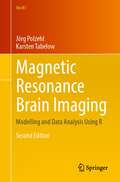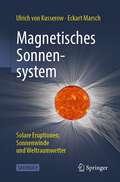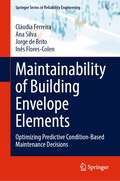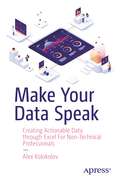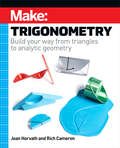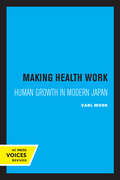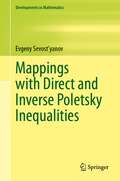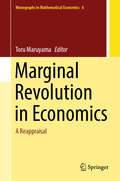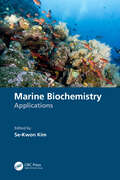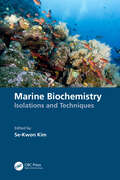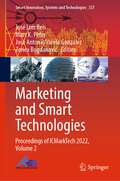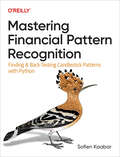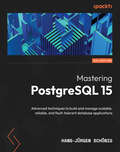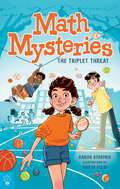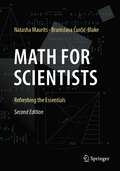- Table View
- List View
Machine Learning for Earth Sciences: Using Python to Solve Geological Problems (Springer Textbooks in Earth Sciences, Geography and Environment)
by Maurizio PetrelliThis textbook introduces the reader to Machine Learning (ML) applications in Earth Sciences. In detail, it starts by describing the basics of machine learning and its potentials in Earth Sciences to solve geological problems. It describes the main Python tools devoted to ML, the typival workflow of ML applications in Earth Sciences, and proceeds with reporting how ML algorithms work. The book provides many examples of ML application to Earth Sciences problems in many fields, such as the clustering and dimensionality reduction in petro-volcanological studies, the clustering of multi-spectral data, well-log data facies classification, and machine learning regression in petrology. Also, the book introduces the basics of parallel computing and how to scale ML models in the cloud. The book is devoted to Earth Scientists, at any level, from students to academics and professionals.
Machine Learning with R: Learn techniques for building and improving machine learning models, from data preparation to model tuning, evaluation, and working with big data, 4th Edition
by Brett LantzLearn how to solve real-world data problems using machine learning and RPurchase of the print or Kindle book includes a free eBook in PDF format.Key FeaturesThe 10th Anniversary Edition of the bestselling R machine learning book, updated with 50% new content for R 4.0.0 and beyondHarness the power of R to build flexible, effective, and transparent machine learning modelsLearn quickly with this clear, hands-on guide by machine learning expert Brett LantzBook DescriptionMachine learning, at its core, is concerned with transforming data into actionable knowledge. R offers a powerful set of machine learning methods to quickly and easily gain insight from your data. Machine Learning with R, Fourth Edition, provides a hands-on, accessible, and readable guide to applying machine learning to real-world problems. Whether you are an experienced R user or new to the language, Brett Lantz teaches you everything you need to know for data pre-processing, uncovering key insights, making new predictions, and visualizing your findings. This 10th Anniversary Edition features several new chapters that reflect the progress of machine learning in the last few years and help you build your data science skills and tackle more challenging problems, including making successful machine learning models and advanced data preparation, building better learners, and making use of big data.You'll also find this classic R data science book updated to R 4.0.0 with newer and better libraries, advice on ethical and bias issues in machine learning, and an introduction to deep learning. Whether you're looking to take your first steps with R for machine learning or making sure your skills and knowledge are up to date, this is an unmissable read that will help you find powerful new insights in your data.What you will learnLearn the end-to-end process of machine learning from raw data to implementationClassify important outcomes using nearest neighbor and Bayesian methodsPredict future events using decision trees, rules, and support vector machinesForecast numeric data and estimate financial values using regression methodsModel complex processes with artificial neural networksPrepare, transform, and clean data using the tidyverseEvaluate your models and improve their performanceConnect R to SQL databases and emerging big data technologies such as Spark, Hadoop, H2O, and TensorFlowWho this book is forThis book is designed to help data scientists, actuaries, data analysts, financial analysts, social scientists, business and machine learning students, and any other practitioners who want a clear, accessible guide to machine learning with R. No R experience is required, although prior exposure to statistics and programming is helpful.
Macroeconometric Methods: Applications to the Indian Economy
by Pami DuaThis book provides empirical applications of macroeconometric methods through discussions on key issues in the Indian economy. It deals with issues of topical relevance in the arena of macroeconomics. The aim is to apply time series and financial econometric methods to macroeconomic issues of an emerging economy such as India. The data sources are given in each chapter, and students and researchers may replicate the analyses.The book is divided into three parts—Part I: Macroeconomic Modelling and Policy; Part II: Forecasting the Indian Economy and Part III: Business Cycles and Global Crises. It provides a holistic understanding of the techniques with each chapter delving into a relevant issue analysed using appropriate methods—Chapter 1: Introduction; Chapter 2: Macroeconomic Modelling and Bayesian Methods; Chapter 3: Monetary Policy Framework in India; Chapter 4: Determinants of Yields on Government Securities in India; Chapter 5: Monetar y Transmission in the Indian Economy; Chapter 6: India’s Bilateral Export Growth and Exchange Rate Volatility: A Panel GMM Approach; Chapter 7: Aggregate and Sectoral Productivity Growth in the Indian Economy: Analysis and Determinants; Chapter 8: Forecasting the INR/USD Exchange Rate: A BVAR Framework; Chapter 9: Forecasting India’s Inflation in a Data-Rich Environment: A FAVAR Study; Chapter 10: A Structural Macroeconometric Model for India; Chapter 11: International Synchronization of Growth Rate Cycles: An Analysis in Frequency Domain; Chapter 12: Inter-Linkages Between Asian and U.S. Stock Market Returns: A Multivariate GARCH Analysis; Chapter 13: The Increasing Synchronization of International Recessions.Since the selection of issues is from macroeconomic aspects of the Indian economy, the book has wide applications and is useful for students and researchers of fields such as applied econometrics, time series econometrics, financial econometrics, forecasting methods and macroeconomics.
Magnetic Resonance Brain Imaging: Modelling and Data Analysis Using R (Use R!)
by Jörg Polzehl Karsten TabelowThis book discusses modelling and analysis of Magnetic Resonance Imaging (MRI) data of the human brain. For the data processing pipelines we rely on R, the software environment for statistical computing and graphics. The book is intended for readers from two communities: Statisticians, who are interested in neuroimaging and look for an introduction to the acquired data and typical scientific problems in the field and neuroimaging students, who want to learn about the statistical modeling and analysis of MRI data. Being a practical introduction, the book focuses on those problems in data analysis for which implementations within R are available. By providing full worked-out examples the book thus serves as a tutorial for MRI analysis with R, from which the reader can derive its own data processing scripts.The book starts with a short introduction into MRI. The next chapter considers the process of reading and writing common neuroimaging data formats to and from the R session. The main chapters then cover four common MR imaging modalities and their data modeling and analysis problems: functional MRI, diffusion MRI, Multi-Parameter Mapping and Inversion Recovery MRI. The book concludes with extended Appendices on details of the utilize non-parametric statistics and on resources for R and MRI data.The book also addresses the issues of reproducibility and topics like data organization and description, open data and open science. It completely relies on a dynamic report generation with knitr: The books R-code and intermediate results are available for reproducibility of the examples.
Magnetisches Sonnensystem: Solare Eruptionen, Sonnenwinde und Weltraumwetter
by Eckart Marsch Ulrich von KusserowDie magnetisch aktive Sonne steht im Zentrum unseres Sonnensystems. Aus ihrer Korona strömt der Sonnenwind stetig in alle Richtungen und formt eine großräumige magnetisierte Plasmahülle um unser Zentralgestirn: die Heliosphäre. Zusammen mit der aus dem Interstellaren Medium eindringenden kosmischen Partikelstrahlung prägt der Sonnenwind die Entwicklung des Weltraumwetters im Interplanetaren Raum sowie in den Magnetosphären und Ionosphären der Planeten. Wie entstehen Kometenschweife und Polarlichter? Welchen Einfluss hat der Sonnenwind auf das Leben im Erdsystem?Unterstützt durch faszinierende Abbildungen astronomischer Himmelsobjekte, durch erklärende Grafiken, wissenschaftliche Originaldaten sowie durch die Verknüpfungshinweise zu Videosequenzen werden die zugrundeliegenden physikalischen Prozesse und neuesten Erkenntnisse didaktisch aufbereitet und mit wenigen mathematischen Herleitungen anschaulich erläutert. Dieses Sachbuch wendet sich allgemein an die gebildete Öffentlichkeit, an Amateurastronomen aber auch an junge Studierende, die sich einen umfassenden Überblick über die generelle Bedeutung magnetischer Vorgänge sowie ein tieferes Verständnis der Prozesse in den Weltraumplasmen unseres Sonnensystems verschaffen möchten.
Maintainability of Building Envelope Elements: Optimizing Predictive Condition-Based Maintenance Decisions (Springer Series in Reliability Engineering)
by Ana Silva Jorge de Brito Inês Flores-Colen Cláudia FerreiraThis book introduces a maintenance model that will assist decision-makers in their choice of building maintenance policies. The model is stochastic and condition-based that analyses the impact of different maintenance strategies on the durability and performance of different buildings envelope elements (facades, windows, and roofs). As non-structural elements, the maintenance of buildings envelope can be disregarded stakeholders. However, as first barrier to the external environment, these elements are critical to buildings' overall performance and are expected to meet aesthetic, comfort, safety, and durability requirements. The methodology presented is innovative. The maintenance model is based on a Petri net formalism and includes degradation, inspection, maintenance, and renewal processes. The model provides key information, such as: i) the impact of different maintenance strategies on the service life and durability of the building components; ii) the impact of maintenance on their performance over time; iii) the life cycle costs; and iv) the impact of maintenance on the buildings' use. The book will be of use to a variety of professionals in the construction sector.
Majeshir Ganit class 1 - NCERT - 23: मजेशीर गणीत वर्ग १ - एनसीईआरटी - २३
by National Council of Educational Research and Trainingइयत्ता पहिलीसाठी आनंददायी गणित या पाठ्यपुस्तकातील आशय NCF-FS 2022 मध्ये नमूद केलेल्या पुढील चार घटकांवर आधारित आहे तोंडी गणित चर्चा, कौशल्य शिकवणे, कौशल्य सराव आणि गणिती खेळ सर्व अध्यायांमध्ये समाविष्ट केले गेले आहेत. त्यापैकी बहुतेक एकात्मिक पद्धतीने सादर केले आहेत. तथापि, खालील प्रकरणे केवळ गणितीय समज आणि क्षमता विकसित करण्याच्या अभ्यासक्रमाच्या उद्दिष्टाशी (CG-8) आणि परिमाणे, आकार आणि मापे यांद्वारा जग ओळखू शकण्याशीच संरेखित नाहीत तर NCF-FS 2022 मध्ये दिलेल्या सर्वांगीण विकासाकडे नेणाऱ्या इतर सर्व अभ्यासक्रम व अभ्यासक्रमिय उद्दिष्टांशीदेखील सरेखित आहेत - मौखिक गणित चर्चा, कौशल्यशिक्षण, कौशल्यसराव आणि गणिती खेळ. बौद्धिक आव्हान आणि विचारप्रवर्तक कार्यांमुळे गणिताचे अध्ययन व निर्णयनक्षमता अधिक चांगल्या प्रकारे होते. मेंदूला सतावणारे प्रश्न, कोडी, कूट प्रश्न यामुळे नेहमीच्या शिकण्याच्या जोडीने मुलांना याची संधी मिळते. मुलांच्या वयाला साजेशी अनेक कोडी या पुस्तकात दिली आहेत.
Majeshir Ganit class 2 - NCERT - 23: मजेशीर गणीत वर्ग २ - एनसीईआरटी - २३
by National Council of Educational Research and Trainingइयत्ता दुसरीसाठी असलेले आनंददायी गणित असे नाव असलेले गणिताचे पाठ्यपुस्तक NEP 2020, NCF-FS 2022 तसेच पायाभरणीच्या टप्प्यासाठीचा अभ्यासक्रम यांच्या शिफारसी डोळ्यासमोर ठेवून तयार केले आहे। बालवाटिका 1 ते 3 तसेच पहिली झाल्यावर (3-8 वर्षे वयात) दुसरीत जाणाऱ्या मुलाला अंकांचे ज्ञान झालेले असते, असे यात गृहीत धरले आहे। परंतु, आपल्या देशातील विविधता बघता, कदाचित काही मुलांची एकदम शाळेत पहिलीत गेल्यावरच पहिल्यांदा अंकांची ओळख होत असेल, असेही होऊ शकते। हे क्रमिक पुस्तक तयार करताना अशा परिस्थितीचाही विचार केलेला आहे। वयाच्या या टप्प्यावरील मुले मुक्तपणे खेळणे, खेळणी यात रमतात। हे लक्षात घेऊन, अवकाशीय समज, अंकहाताळणी, गणितीय आणि संगणकीय संकल्पना इ। शिकवण्यासाठीच्या उपक्रमांमध्ये खेळ, खेळणी यांचा वापर करण्यासाठी पुष्कळ वाव ठेवलेला आहे। यामुळे प्रत्येक नवीन संकल्पना किंवा कौशल्य शिकताना मूर्त वस्तूंकडून चित्रस्वरूपाकडे व त्याकडून अमूर्त कल्पनांपर्यंतचे संक्रमण सहजपणे होऊ शकते। सर्वांगीण विकासासाठी अनुभवातून शिक्षण हे उद्दिष्ट डोळ्यासमोर ठेवून, इयत्ता दुसरीसाठी असलेल्या आनंददायी गणित या पुस्तकामध्ये, वर्गात आणि वर्गाबाहेर करण्यासारखे अनेक उपक्रम दिले आहेत। यातील सर्व प्रकरणांमध्ये, उपक्रमाधारित कार्यांच्या माध्यमातून गणितीय संकल्पनांचे आकलन करून दिले आहे। सक्तीने, नाखुषीने गणित शिकण्याऐवजी, आपण खेळ खेळत आहोत अशा भावनेने मुलांनी हे उपक्रम करावेत आणि त्याद्वारे गणितीय संकल्पना आपोआप रुजाव्यात, अशा प्रकारचे वातावरण निर्माण करण्याचा प्रयत्न या पुस्तकातून केलेला आहे।
Make Your Data Speak: Creating Actionable Data through Excel For Non-Technical Professionals
by Alex KolokolovGather and analyze data successfully, identify trends, and then create overarching strategies and actionable next steps - all through Excel. This book will show even those who lack a technical background how to make advanced interactive reports with only Excel at hand. Advanced visualization is available to everyone, and this step-by-step guide will show you how.The information in this book is presented in an accessible and understandable way for everyone, regardless of the level of technical skills and proficiency in MS Excel. The dashboard development process is given in the format of step-by-step instructions, taking you through each step in detail. Universal checklists and recommendations of a practicing business analyst and trainer will help in solving various tasks when working with data visualization. Illustrations will help you perceive information easily and quickly. Make Your Data Speak will show you how to master the main rules, techniques and tricks of professional data visualization in just a few days.What You'll LearnSee how interactive dashboards can be useful for a businessReview basic rules for building dashboardsUnderstand why it's important to pay attention to colors and fonts when developing a dashboardCreate interactive management reports in Excel Who This Book is ForCompany executives and divisional managers, Middle managers, business analysts
Make: Build your way from triangles to analytic geometry
by Joan Horvath Rich CameronTrigonometry has 2000-year-old roots in everyday useful endeavors, like finding the size of an object too big or far away to measure directly, or navigating from Point A to Point B. However, it is often taught very theoretically, with an emphasis on abstractions. Make: Trigonometry uses 3D printable models and readily-available physical objects like wire and cardboard tubes to develop intuition about concepts in trigonometry and basic analytic geometry. Readers will imagine the thought process of the people who invented these mathematical concepts, and can try out "math experiments" to see for themselves how ingenious ancient navigators and surveyors really were.The analytic geometry part of the book links equations to many of these intuitive concepts, which we explore through in-depth explanations of manipulative models of conic sections. This book is aimed at high school students who might be in Algebra II or Pre-Calculus. It shows the geometrical and practical sides of these topics that otherwise can drown in their own algebra.Make: Trigonometry builds on the basics of the authors' earlier book, Make: Geometry, and is intended as a bridge from that book to their Make: Calculus book. The user can read this book and understand the concepts from the photographs of 3D printable models alone. However, since many models are puzzle-like, we encourage the reader to print the models on any consumer-grade filament based 3D printer. The models are available for download in a freely-available open source repository. They were created in the free program OpenSCAD, and can be 3D printed or modified by the student in OpenSCAD to learn a little coding along the way.
Making Health Work: Human Growth in Modern Japan (Studies in Demography #8)
by Carl MoskMosk shows how population quality provides a key to understanding economic growth and social change in Japan. This title is part of UC Press's Voices Revived program, which commemorates University of California Press’s mission to seek out and cultivate the brightest minds and give them voice, reach, and impact. Drawing on a backlist dating to 1893, Voices Revived makes high-quality, peer-reviewed scholarship accessible once again using print-on-demand technology. This title was originally published in 1996.
Mappings with Direct and Inverse Poletsky Inequalities (Developments in Mathematics #78)
by Evgeny Sevost'yanovThe monograph is devoted to the use of the moduli method in mapping theory, in particular, the meaning of direct and inverse modulus inequalities and their possible applications. The main goal is the development of a modulus technique in the Euclidean space and some metric spaces (manifolds, surfaces, quotient spaces, etc.). Particular attention is paid to the local and boundary behavior of mappings, as well as to obtaining modulus inequalities for some classes. The reader is invited to familiarize himself with all the main achievements of the author, synthesized in this book. The results presented here are of a high scientific level, are new and have no analogues in the world with such a degree of generality.
Marginal Revolution in Economics: A Reappraisal (Monographs in Mathematical Economics #6)
by Toru MaruyamaThis volume is devoted to a reappraisal of the Marginal Revolution on the occasion of its 150th anniversary. The year 1871 should be remembered as one of the most important turning points in the history of economics. W. S. Jevons, C. Menger, and L. Walras published epochal works at the very beginning of the 1870s. Although these works were written independently, they shared a common mathematical structure based on classical analysis. For this reason, the emergence of the trio is called the Marginal Revolution. Indeed, 1871 is the starting point of modern economics in the proper sense. In 1971, several academic conferences were held on the occasion of the 100th anniversary of the Revolution, which exerted the stimulating influence upon the historical researches into the Revolution. Now more than fifty years have passed since then. Economic theory has experienced further substantial changes in researchers’ central interest, the way of reasonings and the styles of description during this period. In view of the new achievements acquired in recent fifty years, it seems an indispensable task for us to review and reevaluate the Marginal Revolution based upon the present status of economics.We also keep in mind that some concepts and doctrines once discarded could reappear in a later stage of history in a more or less transfigured form. The introductory chapter will be a guide for readers not only from the economics community but also from the mathematics community.
Marine Biochemistry: Applications
by Se-Kwon KimThis book provides the latest comprehensive methods for isolation and other novel techniques for marine product development. Furthermore, this book offers knowledge on the biological, medical, and industrial applications of marine-derived medicinal food substances. There has been a tremendous increase in the products derived from marine organisms for commercial application in industries every year. Functional foods of medicinal value are particularly in demand as new technology allows the stabilization of natural ingredients and their availability in pure forms to solve various human diseases. Marine flora and fauna have essential elements and trace minerals that nurture various hormones produced in the endocrine system to regulate the respective metabolisms, thereby providing a safe and healthy life to humans. The overall presentation and clear demarcation of the contents by worldwide contributions is a novel entry point into the market of medicinal foods from the sea. The exploration of marine habitats for novel materials are discussed throughout the book. The exploration and exploitation of the biochemistry of sea flora and fauna are limited, and this book extends the research possibilities into numerous marine habitats. Various approaches for extracting and applying the flora and fauna are discussed. This book will be of value to researchers, marine biotechnologists, and medical practitioners, due to the vast information, as well as industrial and medical applications of marine substances all in one place.
Marine Biochemistry: Isolations and Techniques
by Se-Kwon KimThis book provides the latest comprehensive methods for isolation and other novel techniques for marine product development. Furthermore, this book offers knowledge on the biological, medical, and industrial applications of marine-derived medicinal food substances. There has been a tremendous increase in the products derived from marine organisms for commercial application in industries every year. Functional foods of medicinal value are particularly in demand as new technology allows the stabilization of natural ingredients and their availability in pure forms to solve various human diseases. Marine flora and fauna have essential elements and trace minerals that nurture various hormones produced in the endocrine system to regulate the respective metabolisms, thereby providing a safe and healthy life to humans. The overall presentation and clear demarcation of the contents by worldwide contributions is a novel entry point into the market of medicinal foods from the sea. The exploration of marine habitats for novel materials are discussed throughout the book. The exploration and exploitation of the biochemistry of sea flora and fauna are limited, and this book extends the research possibilities into numerous marine habitats. Various approaches for extracting and applying the flora and fauna are discussed. This book will be of value to researchers, marine biotechnologists, and medical practitioners, due to the vast information, as well as industrial and medical applications of marine substances all in one place.
Marketing and Smart Technologies: Proceedings of ICMarkTech 2022, Volume 2 (Smart Innovation, Systems and Technologies #337)
by José Luís Reis Marc K. Peter Zorica Bogdanović José Antonio Varela GonzálezThis book includes selected papers presented at the International Conference on Marketing and Technologies (ICMarkTech 2022), held at Universidade de Santiago de Compostela, Spain, during December 1–3, 2022. It covers up-to-date cutting-edge research on artificial intelligence applied in marketing, virtual and augmented reality in marketing, business intelligence databases and marketing, data mining and big data, marketing data science, web marketing, e-commerce and v-commerce, social media and networking, geomarketing and IoT, marketing automation and inbound marketing, machine learning applied to marketing, customer data management and CRM, and neuromarketing technologies.
Mastering Financial Pattern Recognition: Finding and Back-Testing Candlestick Patterns with Python
by Sofien KaabarCandlesticks have become a key component of platforms and charting programs for financial trading. With these charts, traders can learn underlying patterns for interpreting price action history and forecasts. This A-Z guide shows portfolio managers, quants, strategists, and analysts how to use Python to recognize, scan, trade, and back-test the profitability of candlestick patterns.Financial author, trading consultant, and institutional market strategist Sofien Kaabar shows you how to create a candlestick scanner and indicator so you can compare the profitability of these patterns. With this hands-on book, you'll also explore a new type of charting system similar to candlesticks, as well as new patterns that have never been presented before.With this book, you will:Create and understand the conditions required for classic and modern candlestick patternsLearn the market psychology behind themUse a framework to learn how back-testing trading strategies are conductedExplore different charting systems and understand their limitationsImport OHLC historical FX data in Python in different time framesUse algorithms to scan for and reproduce patternsLearn a pattern's potential by evaluating its profitability and predictability
Mastering PostgreSQL 15: Advanced techniques to build and manage scalable, reliable, and fault-tolerant database applications, 5th Edition
by Hans-Jurgen SchonigMaster the capabilities of PostgreSQL 15 to efficiently administer and maintain your database.Purchase of the print or Kindle book includes a free PDF eBook.Key FeaturesUsing real world examples, get to grips with expert PostgreSQL 15 conceptsExplore performance improvement, database replication, data replication, database administration, and moreExtend PostgreSQL's functionalities to suit your organization's needs with minimal effortBook DescriptionStarting with an introduction to the newly released features of PostgreSQL 15, this updated fifth edition will help you get to grips with PostgreSQL administration and how to build dynamic database solutions for enterprise apps, including designing both physical and technical aspects of the system.You'll explore advanced PostgreSQL features, such as logical replication, database clusters, advanced indexing, and user management to manage and maintain your database. You'll then work with the PostgreSQL optimizer, configure PostgreSQL for high speed, and move from Oracle to PostgreSQL. Among the other skills that the book will help you build, you'll cover transactions, handling recursions, working with JSON and JSONB data, and setting up a Patroni cluster. It will show you how to improve performance with query optimization. You'll also focus on managing network security and work with backups and replication while exploring useful PostgreSQL extensions that optimize the performance of large databases.By the end of this PostgreSQL book, you'll be able to use your database to its utmost capacity by implementing advanced administrative tasks with ease.What you will learnMake use of the indexing features in PostgreSQL and fine-tune the performance of your queriesWork with stored procedures and manage backup and recoveryGet the hang of replication and failover techniquesImprove the security of your database server and handle encryption effectivelyTroubleshoot your PostgreSQL instance for solutions to common and not-so-common problemsPerform database migration from Oracle to PostgreSQL with easeWho this book is forThis database administration book is for PostgreSQL developers, database administrators, and professionals who want to implement advanced functionalities and master complex administrative tasks with PostgreSQL 15. Prior experience in PostgreSQL and familiarity with the basics of database administration will assist with understanding key concepts covered in the book.
Mastery Mathematics for Primary Teachers
by Robert NewellThis book examines how mathematical mastery, influenced by East Asian teaching approaches, can be developed in UK schools to enhance teaching and to deepen children’s mathematical knowledge. It gives guidance on using physical resources to demonstrate key concepts, extended examples on how to teach different curriculum topics and how to plan for small-step progression. It argues that effective mastery teaching requires careful and knowledgeable support for primary teachers who may not yet be maths specialists. New to this second edition: New chapter on variation theory and practice Updated case studies exploring how mastery teaching has evolved Updated review of current mastery resources available to UK teachers Robert Newell is a lecturer at the UCL Institute of Education, London.
Mastery Mathematics for Primary Teachers
by Robert NewellThis book examines how mathematical mastery, influenced by East Asian teaching approaches, can be developed in UK schools to enhance teaching and to deepen children’s mathematical knowledge. It gives guidance on using physical resources to demonstrate key concepts, extended examples on how to teach different curriculum topics and how to plan for small-step progression. It argues that effective mastery teaching requires careful and knowledgeable support for primary teachers who may not yet be maths specialists. New to this second edition: New chapter on variation theory and practice Updated case studies exploring how mastery teaching has evolved Updated review of current mastery resources available to UK teachers Robert Newell is a lecturer at the UCL Institute of Education, London.
Math Magic Semester-1 class 3 - Andhra Pradesh Board
by State Council of Educational Research and Training Andhra PradeshThe Class 3 Andhra Pradesh Maths Magic Semester 1 textbook is designed to enhance foundational mathematical skills in alignment with the latest educational standards and approaches. It introduces students to concepts through engaging, real-life contexts and activities such as shopping scenarios, games, and visual aids like abacuses and number blocks. Key topics include the number system, addition, subtraction, multiplication, and division, progressing from basic to advanced levels. Each chapter incorporates exercises to strengthen understanding, with sections like “Do these,” “Try these,” and “Exercises,” offering a mix of simple and challenging problems. The textbook also integrates QR codes for supplementary digital learning, fostering interactive and practical learning experiences. Teachers are provided with structured guidance to maximize classroom learning, emphasizing group, individual, and whole-class activities. Activities like creating numbers from digit cards or exploring patterns make learning enjoyable and contextual. Additionally, the textbook reflects a bilingual approach, making concepts accessible to all students. By blending mathematical theory with hands-on practice, the book aims to cultivate critical thinking, problem-solving skills, and logical reasoning in young learners while adhering to global educational standards. This textbook is a part of Andhra Pradesh’s initiative to ensure quality education and equip students with 21st-century skills.
Math Magic Semester-2 class 3 - Andhra Pradesh Board
by State Council of Educational Research and Training Andhra PradeshThe Class 3 Andhra Pradesh Maths Magic Semester 2 textbook builds on the foundational mathematical concepts introduced in Semester 1, continuing to enhance problem-solving and critical thinking skills. Aligned with modern educational standards, the textbook introduces topics such as multiplication, division, fractions, data handling, geometry, measurements, and the concept of time. Lessons are designed to relate math to daily life, using engaging contexts like sharing resources, playing games, and solving practical problems. Each chapter includes structured activities under sections like “Do These,” “Try These,” and “Exercises,” which cater to varying levels of difficulty, ensuring inclusive learning for all students. Real-life examples, visual aids, and interactive activities like tallying, dividing objects, and measuring items make learning dynamic and enjoyable. A bilingual approach (English and Telugu) ensures accessibility for a diverse student base. QR codes in chapters offer digital learning opportunities, promoting a blended learning experience. Teachers are guided with instructions to implement group, individual, and classroom-wide activities effectively. The book emphasizes hands-on exploration, fostering logical reasoning, collaboration, and creativity. As part of Andhra Pradesh’s educational reform, this textbook strives to deliver quality education and equip young learners with essential 21st-century skills while making mathematics fun and relatable.
Math Magic Semester-2 class 5 - Andhra Pradesh Board
by State Council of Educational Research and Training Andhra PradeshThe Class 5 Andhra Pradesh Maths Magic Semester 2 textbook is designed to build advanced mathematical skills in students while adhering to modern educational standards. It introduces topics such as geometry (points, lines, angles), fractions (types, addition, subtraction), data handling (bar graphs, pictographs), and measurements (length, area, perimeter, and volume). Lessons are crafted to relate mathematical concepts to real-life scenarios, using activities like drawing symmetrical patterns, measuring objects, and calculating with fractions. The book adopts a bilingual (English and Telugu) approach, making it accessible to a diverse audience. Engaging exercises and hands-on activities, including project work and QR-code-enabled resources, encourage interactive and practical learning. Structured guidance for teachers ensures effective lesson delivery, emphasizing group and individual tasks. This textbook aims to enhance logical reasoning, problem-solving, and analytical skills in students, aligning with global educational practices. It integrates fun and relevance, making mathematics enjoyable and applicable to daily life.
Math Mysteries: The Triplet Threat (Math Mysteries #1)
by Aaron StarmerA page-turning mystery brimming with lighthearted intrigue and essential middle-grade math skills, Math Mysteries: The Triplet Threat by author Aaron Starmer will have readers on the edge of their seats as they unravel the who-done it using math. Perfect for both mystery and math lovers, as well as kids who love puzzles, riddles, brainteasers, and adventure stories! It's the first day of the fourth grade at Arthimos Elementary and things are already off to a strange start--poisonous cookies, a zipline disaster, a missing iPad, and what are those strange sounds coming from the school custodian's wheelbarrow? Luckily the Prime Detectives--Abby “the Abacus” Feldstein, Cameron “Cam” McGill, and Gabriel “Gabe” Kim--are on the case! Using arithmetic, geometry, and logic, the Prime Detectives are sure to figure out who did what, when, and why! A gripping new middle grade mystery series, each book contains multiple, interlinked mysteries that readers help solve using math. Includes answers showing step-by-step solutions.
Math for Scientists: Refreshing the Essentials
by Natasha Maurits Branislava Ćurčić-BlakeThis book reviews math topics relevant to non-mathematics students and scientists, but which they may not have seen or studied for a while. These math issues can range from reading mathematical symbols, to using complex numbers, dealing with equations involved in calculating medication equivalents, the General Linear Model (GLM) used in e.g. neuroimaging analysis, finding the minimum of a function, independent component analysis, or filtering approaches. Almost every student or scientist, will at some point run into mathematical formulas or ideas in scientific papers that may be hard to understand, given that formal math education may be some years ago. In this book we will explain the theory behind many of these mathematical ideas and expressions and provide readers with the tools to better understand them. We will revisit high school mathematics and extend and relate this to the mathematics you need to understand the math you may encounter in the course of your research. This book will help you understand the math and formulas in the scientific papers you read. To achieve this goal, each chapter mixes theory with practical pen-and-paper exercises such that you (re)gain experience with solving math problems yourself. Mnemonics will be taught whenever possible. To clarify the math and help readers apply it, each chapter provides real-world and scientific examples.In this new edition, two new chapters covering statistics and differential equations have been added, which have been workshopped in the 'authors' popular lecture series in order to maximize the benefit for readers.
